Daniel Fine
(dis)APPEAR(d)ances
Dance and Digital Media Design
Co-Creator, Digital Media Designer, System Designer, and Set Designer
Role:
Peer-Reviewed Outcomes/Dissemination:
November 2019
Performance: Dance Gala, Hancher Auditorium. University of Iowa. Iowa City, IA
Photo Gallery:



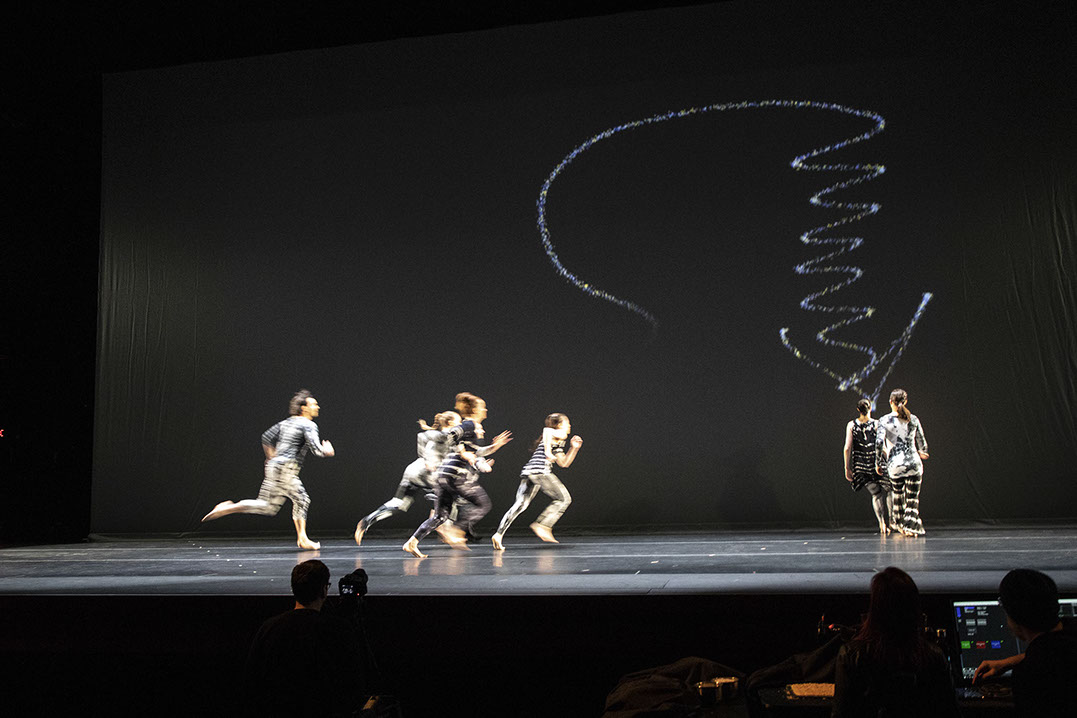
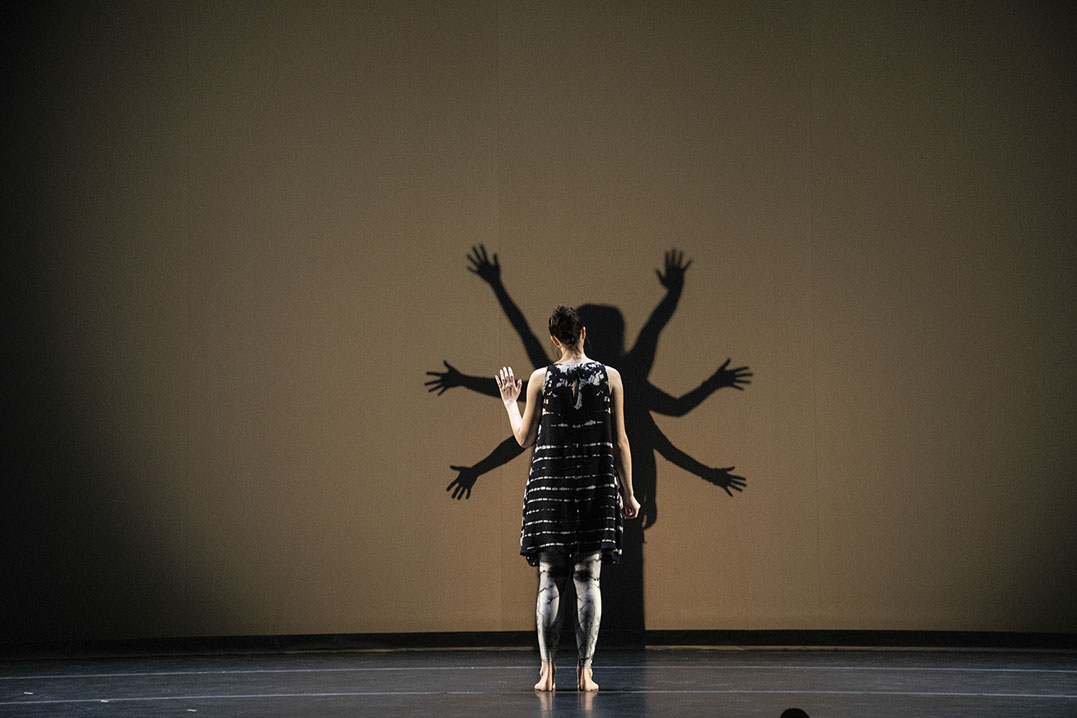
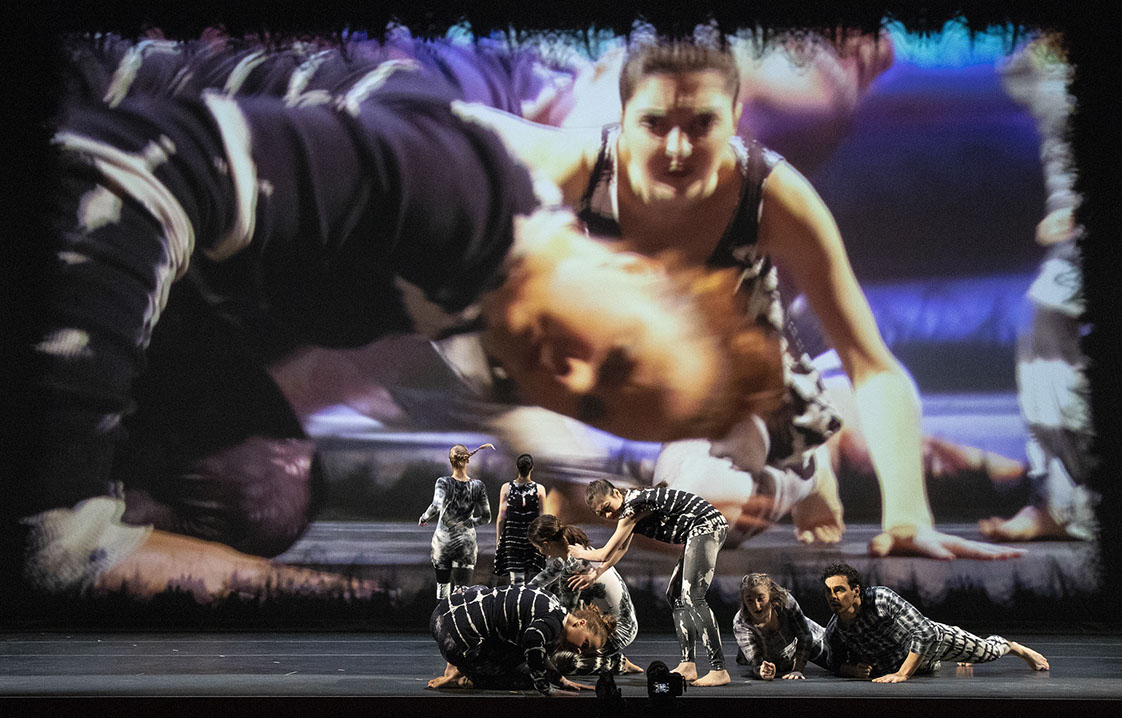

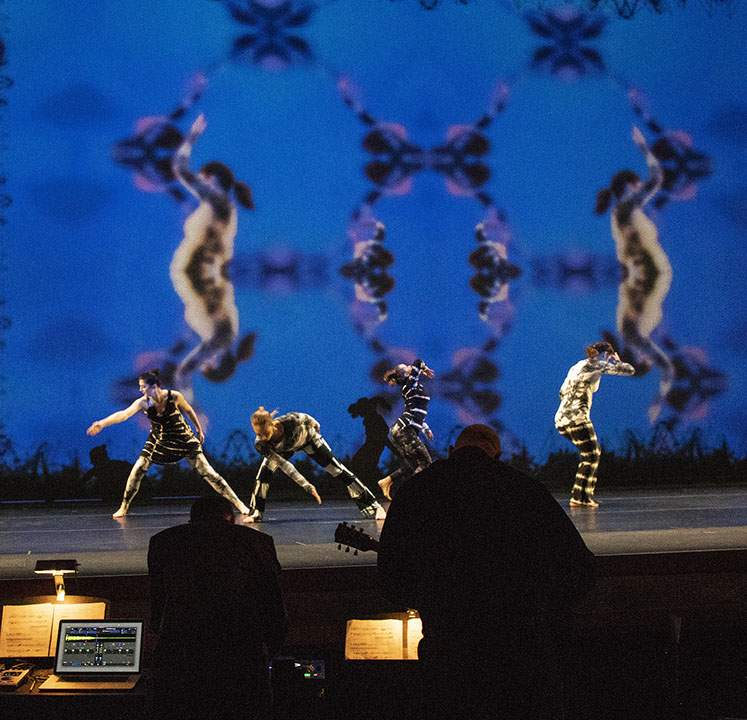
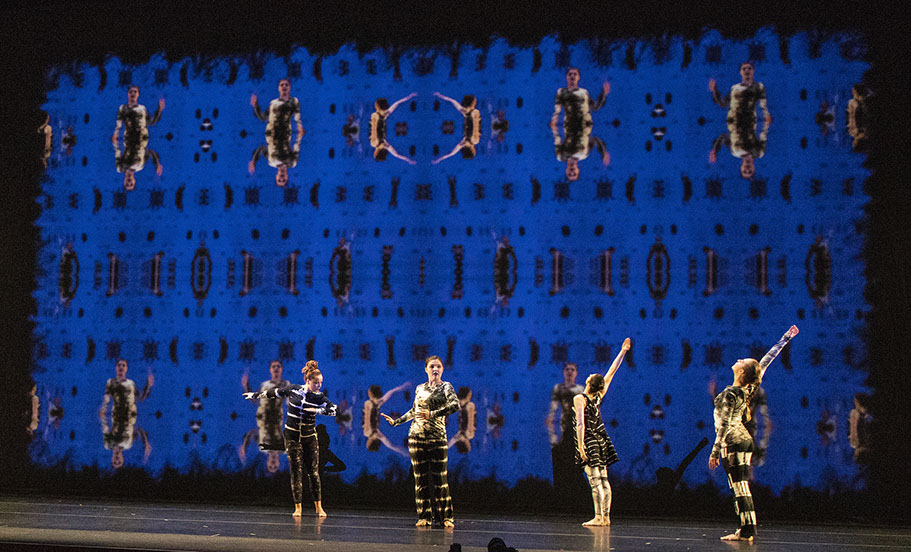
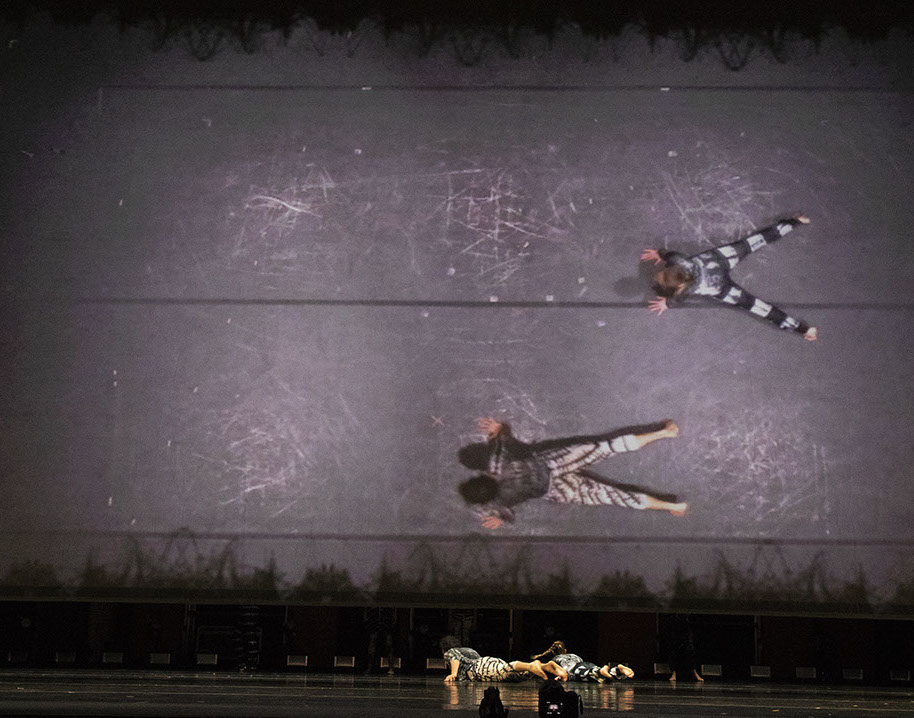
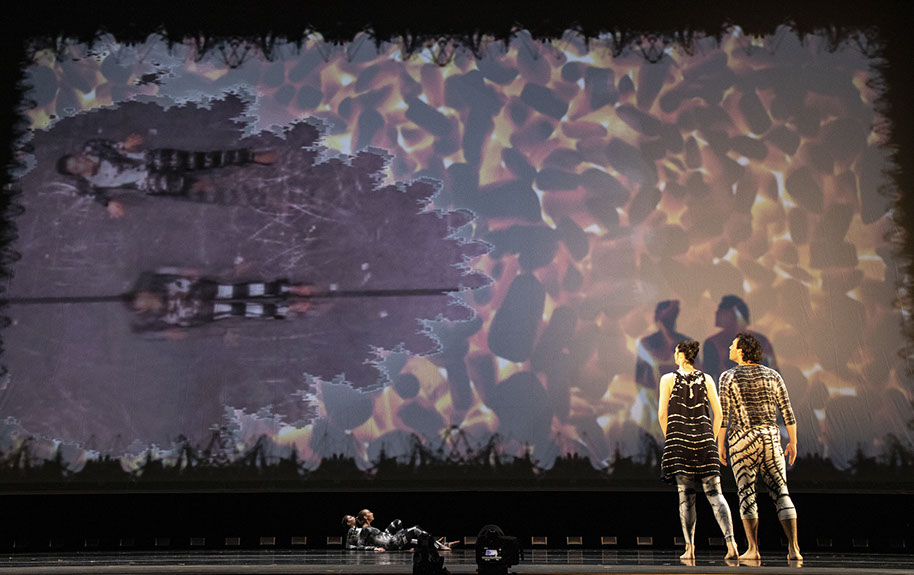
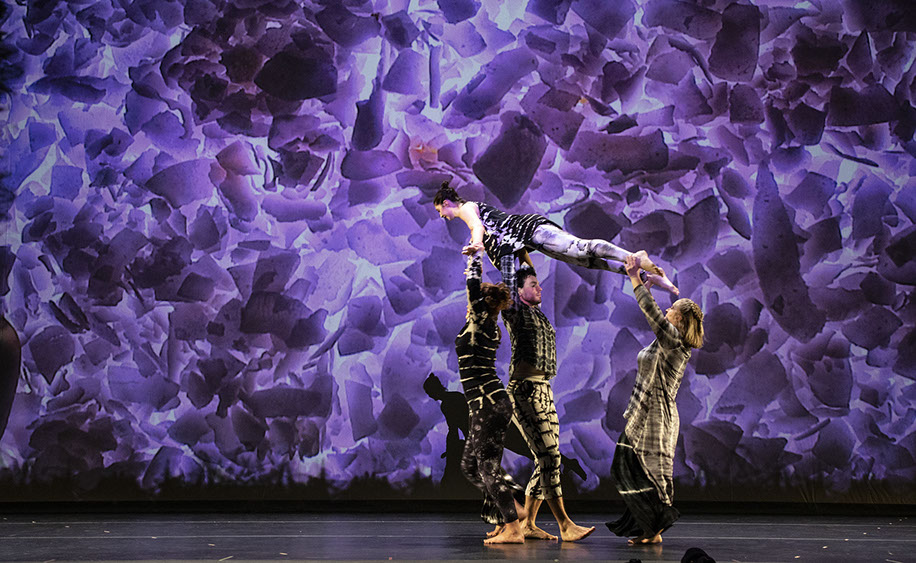
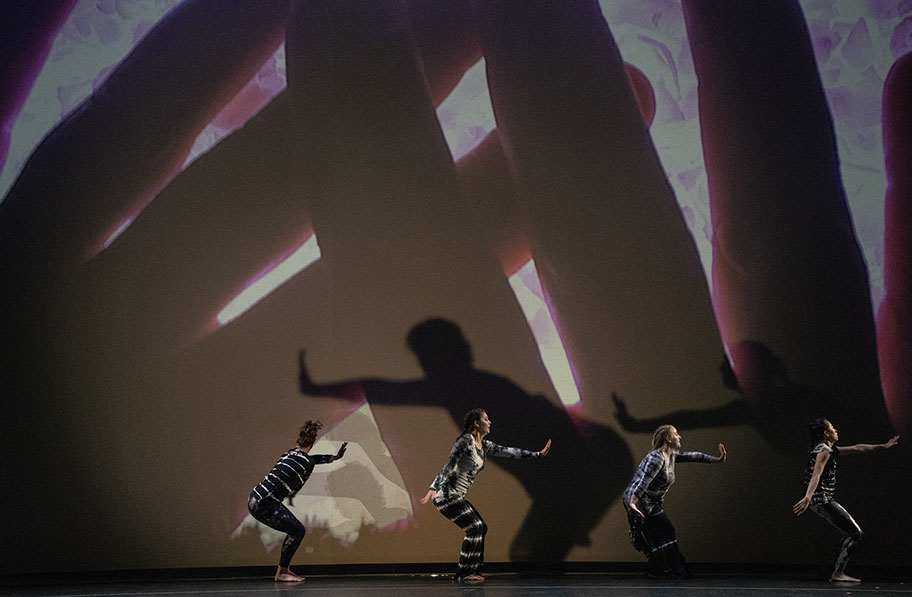
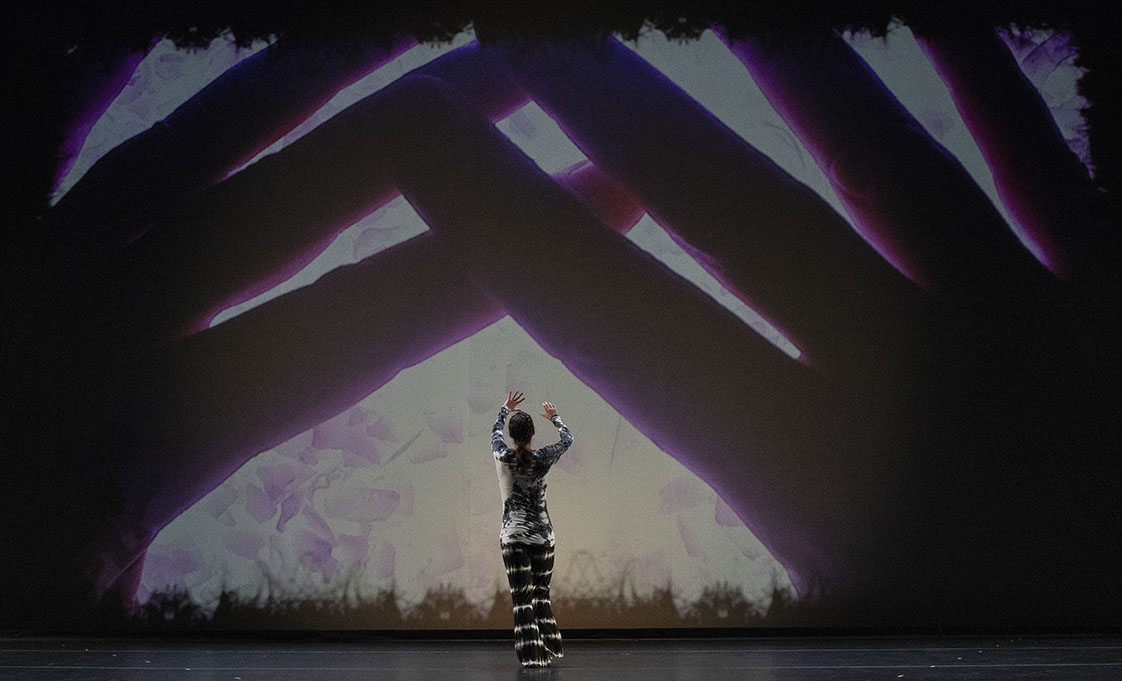
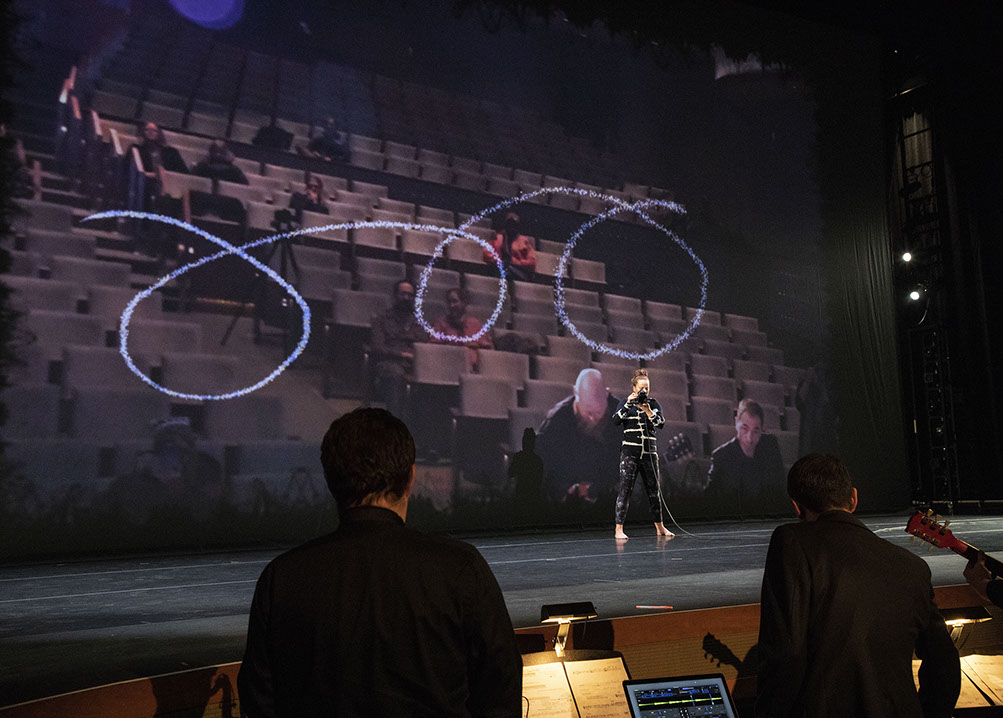
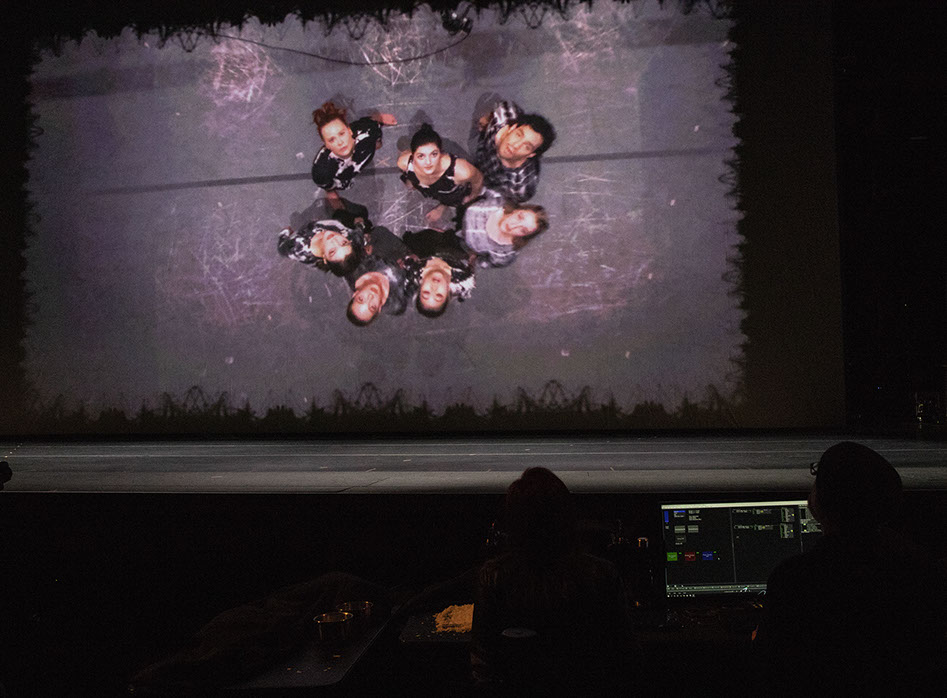
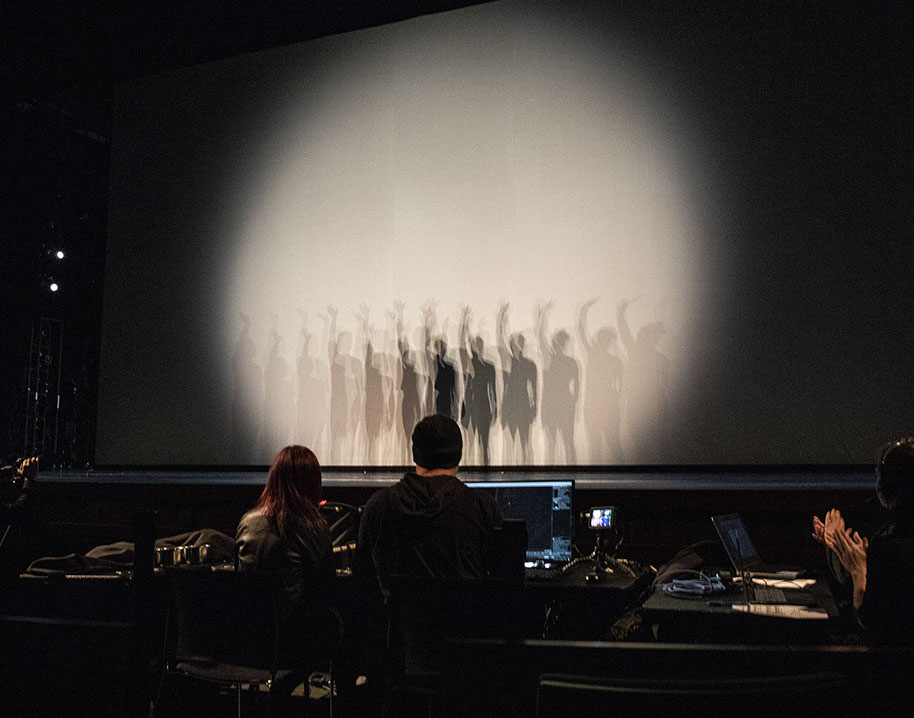
The beginning. After finding our way through the audience, two of the co-creators look out to the audience. All photos by Dana Keeton.
Drawing on an iPad, which is connected to the media system and projected in real-time. The dance makers call the dancers.
The dancers heed their call and enter the stage.
The dance makers play with the dancers, making them go here and there.
Some dancers discover behind the screen and a mediated, low-tech, shadow version of themselves.
The dancers discover a live camera that projects mediated versions of themselves on a slight delay.
An old video trick, creating an infinity with the camera looking at the projected image. Multiple delays applied to the video.
The dancers' bodies become a kaleidoscope. The musicians in the foreground.
The dances' image multiplies and creates repeating patterns.
The screen raises three feet and we see behind it and a live camera feed from above.
Projected background: corn on lightboard is projected via an overhead camera.
Projected background: coconut flakes on lightboard is projected via an overhead camera. Color effect applied in real-time.
Background projection: my hands over the coconut flakes. Shadows of dancers behind the screen.
Dancer tries to connect to my hands.
A dancer discovers her power to manipulate the POV of the camera. She points it to the audience.
The dancers behind the screen. Looking up at a live camera that slowly raises to the top of the fly house.
Curtain call.
1 - 17
<
>
Video:
Key Creative Team:
Co-Creator | Choreographer | Jennifer Kayle
Assistant Choreographer & Digital Media Designer | Kate Vincek
Assistant Digital Media Designer | Nicholas Coso
Assistant System Designer & Integration | Travis Kelley
Costume Designer | Margaret Wenk-Kuchlbauer
Lighting Designer | Laurel Shoemaker
Original Music | Jean-Francois Charles, Joseph Norman, Jonathan Williams
Dancers | Erin Evans, Emily Guma, Michael Landez, Juliet Remmers, Alyssa Simpson, Sarah Skilling, Anna Wetoska
Additional Photography | Dana Keeton
Program Notes:
Everything you see and hear in this work (except one thing, cause nothing is ever everything) is made in real-time. Right now. This moment. Here. (with you) But where is here? And when is now? What is before? Where is after? Why is . . .
Process/Creative:
In late 2017, after seeing my dance Gala collaboration with choreographer Charlotte Adams, Associate Professor Jennifer Kayle asked about working on a collaboration. She had never worked so heavily with technology in a show and was curious to explore the possibilities she saw in the use of live cameras and large-scale, immersive projection. I liked all of JK’s work that I had seen and how she talks about and approaches the work and the process. We were also developing a friendship and I knew it would be fun and easy to work together - something that is extremely important to me when choosing collaborators.
For a year we talked informally about a collaboration for someday. It wasn’t until fall 2018 that we actually decided the time was right. We began brainstorming ideas for a proposal for a new work for inclusion in Dance Gala 2019 – to be premiered in Fall of 2019.
Our early discussions centered around themes we were interested in exploring, methods of creation, technology we wanted to experiment with, use of space/theatricality, and additional collaborators we would need to bring into the project.
Themes:
JK and I were interested in the ways modern audiences who are consumed by screens see dance and dancers, how the dancers see themselves and each other and the entire work, and in a broader context, how we as humans see ourselves and others. This led us to discussions on the mediation of bodies. What changes when a dance/dancer is viewed unfiltered directly with human eyes vs. being mediated and displayed. Clearly any form of mediation of a body introduces a point of view. Who is the viewer? Why are they watching? How are they watching? How will the mediation of the body be captured? How will it be displayed for others to see?
These questions were important not just on a technical level, but also philosophically and metaphorically. What does it mean to be viewed as a human? As a dancer, specifically? What does it mean to view other humans, dancers in particular? Do various views of the mediated body and different POVs of the movement/performance offer a different view into the performative world? What does it mean to be within and to view a live embodied performance with simultaneous views of the meditated body? What happens to an audience’s view and understanding of embodiment when seen through different lenses, screens, etc?
These questions drove our entire process. We were more interested in the exploration of answering these questions and the new questions each attempted answer brought than actually finding concrete answers.
At the same time, Igby, my thirteen year old cat, just died. He was consistently on me – on my lap when sitting, on my shoulders when standing, on my chest when laying down, his head resting on the keyboard with a paw on my hand as I typed at my desk. His death was a terrible loss for me, especially physically. I could feel his absence. This notion of presence and absence also resonated with JK and began to influence the conversations we were having about viewing in new ways. How could mediation or the lack thereof be used to explore narratives of presence and absence, loss and recovery? How could technology mediate and present the choreographed body that frames and highlights a POV to create an experience through staged scenes of appearance and disappearance, interactions of light and shadow, and choreographed erasures of body and space?
Approach:
Inspired by the Black Mountain College collaborations of Merce Cunningham, John Cage, and Robert Rauschenberg, our exploration would be created through the holistic approach of a shared system; a multi-faceted approach to “story-telling” that would draw equally on the active participation of all members of the ensemble, movement, technology, viewership, various methods of mediating the body, the space, and the exploration of the themes.
It was clear that we needed another main collaborator to create the music. We invited composer and Assistant Professor Jean-Francios Charles to work with us. In our early conversations it became clear to the three of us that we all shared an interest in creating a work that had had a set score (in terms of the music, dance and visuals), but would also allow room for live improvisation between the dancers, the musicians and myself and JK who would be running a live VJ station to create visuals.
As a designer, I was interested in creating the majority of the content live, in real-time using various forms and representations of the live bodies moving in space. Of the eighteen minute final piece, only 1 pre-recorded movie totaling just over a minute was used. Every other visual was created live, in the moment using the physical bodies in the theatre (dancers and audience) as the base content to present/frame either straight or manipulated with post-processing effects added.
My inspiration for post-processing effects to alter the moving bodies came from fractals, mirrors, reflection, delay, decay, motion blur, and kaleidoscopes.
In addition to creating backgrounds by manipulating the forms of the dancers bodies, I created a system using a lightbox with a live-camera overhead. In rehearsal we experimented with different items on the lightbox to create/destroy different backdrops and settings. Shadows of my live, choreographed hands were also used to frame/interact with the dancers via the lightbox.
Part of the explorations was JK and I communicating to the dancers and the audience. This was achieved by using an iPad particle emitter app. I had used this app before and had already put in 40+ hours into developing a custom particle effect that would allow JK and I to use our fingers to draw and write. The iPad was connected directly to the media server to display the live writings/drawings. There was also a live-camera above the iPad so that I could switch to a POV where our hands are seen drawing. The purpose of this camera was to reveal that we were making this content in real-time and to mediate our bodies, not just the results.
In addition to using live cameras to mediate the body, we were interested in exploring earlier technological methods of mediating bodies, such as shadows. We collaborated with our lighting designer to use theatrical lights to create shadows of the dancers. This low-tech form of mediating the body also played into our themes of presence/absence in a more ancient and ritualistic way that allowed us to tap into a more earthy and existential exploration of presence.
Along with how we would create the visuals of the mediated body, the question of how we would display all the forms of the mediated body was crucial. Screens dominate our modern world, but most of these screens are self-emitting. We were interested in using projection as our display technology, not only because it was the only technology our budget could afford, but because of the inherent meaning and quality of this type of display. Projected light reflected off a screen serves all the thematic questions we were wrestling with. Technically it also offers a different quality of light – something that is more ethereal. We were interested in how we could treat the display surface – the screen - the same way we were thinking about the dancers and the movement. Could the screen be both present and absent? In addition to creating a method by which to see, could it also be a device by which to hide/reveal?
The screen also presented a physical method in which to play with scale. The Hancher Auditorium, the performance venue for the piece, is grand in every way. The stage is huge and the audience seating is vast. I ended up being the set designer in the sense of our scenic piece was the screen and the space itself. The placement of the screen upstage to downstage allowed us to change the depth of scale of the physical stage, providing opportunities to drastically cut the stage by more than half when the screen was in and revealing the entire, unmasked stage when the screen was flown out. We also played with changing the space by the vertical position of the screen – all the way in/out and set at various heights. The screen became the device, the one physical set piece that could obstruct and reveal various views of the stage and the work, while providing discrete performing spaces upstage and downstage and in vertical space.
We activated the entire space and allowed most manipulations to be visible to the audience. The musicians, the student assistant designers, JK and myself all entered from the audience. This connected us with the audience, while also activating it as a performance space and foreshadowing the ending where we would turn the camera and gaze to the audience itself by putting the camera on the audience and allowing them to see themselves. The musicians stood in the orchestra pit while JK and myself were in a VJ station along with student assistants on the other side of the orchestra pit. Having us in view both physically and at times mediated via a camera projected onscreen exposed elements of how we were creating the piece in real-time. The performance wasn’t just contained to the stage or even the venue– at the end we zoomed out from the physical stage and performance venue to the outer reaches of space. This final fly out situated us as humans and our place and scale within the universe. This was achieved with a live camera attached to a fly-rail that on cue was flown out (up) and then cut to a similar fly-out of Google Earth and then into Space. This flyout, from the venue on, was the only pre-recorded video in the entire piece.
Casting:
Because the dancer’s bodies were going to be making up nearly all of the projected content it was important when casting to not only factor in the normal choreographic considerations, but also the dancers ease of use with some of the technologies we were going to be incorporating since they would actively be interacting with and manipulating these technologies. During the audition I set-up three one-camera/projector systems for groups of dancers to use. JK created a few movement phrases she wanted the dancers to incorporate and we provided a prompt for each auditioning group. It was vital for us to see how the dancers moved, their ability to collaborate with each other, their sense of creativity, and how they thought about and used the camera and the projectors.
Rehearsals:
It was clear before we started that we would need to have a rehearsal system with the technology in the room in order to create this piece. We used the dance theatre, Space Place, as a rehearsal hall and setup a mock rehearsal system – closely approximating the final system in the performance venue.
Our guiding mantra in rehearsal became “honoring the process.” We allowed the answers to questions to take us places that we hadn’t predicted. This meant we explored and created a lot of work that ultimately did not make it into the final piece, as we were testing what worked and what didn’t. Rather than discount what was happening in the room, we listened and shifted based on daily discoveries.
Teaching/Service:
All creative works made in collaboration with students is also about teaching. It is important to me to provide as much opportunity to students as possible. For this process, I had three student assistants. One graduate designer from theatre was in charge of pre-recorded content, effects, editing, etc. As the piece developed and it became clear that we would only be using one pre-recorded video, he shifted into helping run the live-system. One undergraduate engineering major was in charge of system integration. The most existing position was that of an MFA choreographer who served as both Assistant Choreographer and Assistant Digital Media Designer. Her role became a bridge between the two disciplines, helping to synthesize vocabularies and working methods.
Press:
"While Dance Gala works often include cross-collaborations, Jennifer Kayle and Daniel Fine’s piece, “(dis)APPEAR(d)ances,” is pushing boundaries in dance, digital media and music, by playing with how media affects experiences of presence and absence." - Best Bets: Dance Gala: ‘In Motion’, The Gazette. For full article, click here.
copyright 2024
